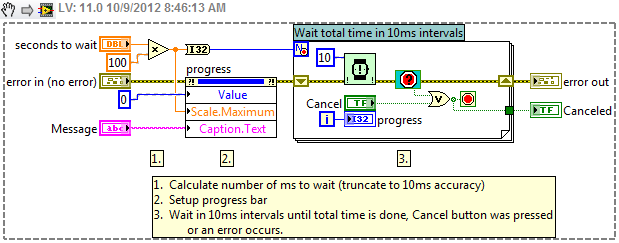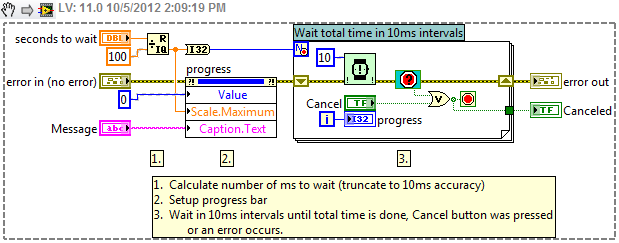-
Posts
548 -
Joined
-
Last visited
-
Days Won
25
Content Type
Profiles
Forums
Downloads
Gallery
Everything posted by crossrulz
-
Assuming 2013 or 2014 even ship
-

Build Scripts
crossrulz replied to Daklu's topic in Application Builder, Installers and code distribution
Fab, my testing concurrs with yours (LabVIEW 2011 SP1) -
I know you meant for this to be rhetorical, but about all you really can do is send in the crash reports and do what you have done. Finding the exact cause of the bugs is sometimes really hard to do. But R&D is doing a lot of work. Maybe your bug was fixed in the 2013 beta. Maybe they are still trying to figure out where the exact problem is. I understand your frustrations, but after attending the CLA summit this year I realized just how much work the R&D folks are doing between bug fixes and making the language better.
-

May I use LabVIEW for commercial software?
crossrulz replied to lovemachinez's topic in LabVIEW General
You will need the App Builder, which comes with the Professional version. In order to run your EXE, you will have to install the LabVIEW Run-Time Engine (RTE). Also be sure to read all of the EULA for LabVIEW. There's language in there that you have to put NI's copyright for LabVIEW in an About Box and/or elsewhere in your application. I'm a little fuzzy on the exact details at the moment. -
They are in the February/March time frame. So I would it should be out within a month or so. There shouldn't be anything new in it. Just major bug fixes.
-

Shared clone reentrant execution. How can I get clones shared?
crossrulz replied to _Y_'s topic in LabVIEW General
The problem is that you are dynamically calling your VIs. So once the dynamic VI is complete, it is pulled out of memory. So your clones are being disposed of when they complete.- 4 replies
-
- asynchronous
- reentrant
-
(and 2 more)
Tagged with:
-

How to handle extra data in a queue?
crossrulz replied to george seifert's topic in Application Design & Architecture
If you only care about the latest data, a notifier is the guy you want. A queue is for lossless data transfer. A notifier is for lossy data transfer. -

"Closing References in LabVIEW": New documentation published
crossrulz replied to Aristos Queue's topic in LabVIEW General
That's a lot of good information. Thank you for the article. -

Good resources for Best OOP Practices?
crossrulz replied to Mike Le's topic in Object-Oriented Programming
Cross-posted on the dark side -

Some Questions regarding preparation for CLAD
crossrulz replied to JaviRome's topic in Certification and Training
I have not gone through the LabVIEW for Everyone. But from quick skimming, it looked really good. The LabVIEW Style Book is really good, but it won't help you with the CLAD. I found the Advanced LabVIEW Techniques worthless. There's no code in it! The Basics I and II course books should be really helpful. The core of LabVIEW hasn't changed much. Here are some links that may help you in your studies. CLAD Information on NI.com - there's a few links for practice exams and other study material The Daily CLAD on NI Communities - CLAD-like questions to get you thinking about possible topics -
NI sells them:http://sine.ni.com/tacs/app/fp/p/ap/ov/lang/en/ol/en/oc/us/pg/1/sn/n5:selfpaced/
-

Dropping control from palette: making it wire up the conpane?
crossrulz replied to Steen Schmidt's topic in VI Scripting
I was thinking of simply making a quick drop shortcut to do this. Just haven't found the time to make it yet.- 5 replies
-
- error cluster
- scripting
-
(and 2 more)
Tagged with:
-
Congrats.
-
Is this a CAR for the Delete From Array? I sure wish we had visibility into the CAR database...
-
Just a general comment: There is no need to set your file position inside of the loop. The position increments during the read. After a read, the position will be set to the next byte, so the the next read will start where the previous left off.
-

String to 1D String Array, painfully slow
crossrulz replied to Findus's topic in Application Design & Architecture
I fully agree with Philip. You can right-click on the Read from Text File and select "Read Lines". The glyph will change. Set the count to -1 to read the entire file in lines (the default becomes 1 line). The other option you have is to use the Spreadsheet String to Array. -
-
Yeah, my benchmarks found that the delete from array was really slow. What I ended up doing in the proposed VI was to reverse the array and then index the first element. This method was slightly faster than the index array size -1.
-
Yep. I goofed it up when cleaning up. Will repost when I get a chance to fix it later today.
-
They actually use the Reshape array. But the math for how to setup the dimentions is done inside these VIs.
-
More submissions to OpenG. This time I have a few array functions that I have had to use over the years. These VIs are for taking a 1D array and turning it into a 2D array, taking a 2D array and turning it into a 1D array, and to simply get the last element of at 1D array. Thoughts? Critisism? Praise? Ideas to make it better? Good for OpenG? 1D to 2D array.llb 2D to 1D array.llb Final Array Element.llb
-
Here is another VI I am submitting for OpenG. It is for when you have to wait for something to happen and this wait is in the domain of seconds. You don't want the user sitting there wandering if the program froze. So I made a VI for these long waits that includes a progress bar. Notice that this VI uses my Global Stop VI found here. Thoughts? Critisism? Praise? Ideas to make it better? Good for OpenG? Long Wait.vi




